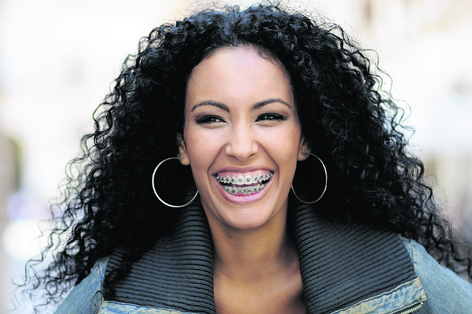Regret never getting those wonky gnashers fixed as a child? It’s never too late to smarten up that smile.
Our smiles play a big role in first impressions, not to mention the fact that being able to laugh and grin freely is part and parcel of being happy, so it’s little wonder that being plagued by self-consciousness due to crooked teeth can have a major dent on confidence levels.
A recent survey commissioned by teeth straightening experts Align Technology found that one in five (20%) of adults feel they get judged on the basis of how higgledy-piggledy their gnashers are.
It seems men are more affected, with 23% admitting they feel anxious about people judging their teeth, compared to 17% of women.
However, it’s a myth that if you didn’t get a mouthful of metal braces aged 13, you’ve missed your chance altogether. Whatever your age, it’s not too late to get overcrowded, wonky teeth straightened out by an orthodontist.
So, if you do want to neaten up your smile, this is what you need to know.
WHAT TREATMENTS ARE AVAILABLE?
Invisalign works by repositioning teeth little by little, using a series of custom-made clear plastic ‘aligners’ which are changed every two weeks. Digital scanning technology and 3D software is used to plot the way the teeth should move over a period of weeks – so you can see how your teeth should look at the end of the treatment before even starting.
Alternatively, you can go classic with traditional metal train tracks which are tightened over time to pull teeth gradually into place.
DOES IT MATTER HOW OLD I AM?
Karen Coates, from the British Dental Health Foundation (BDHF), says: “You are never too old to get your teeth straightened. There has been a huge surge in people wanting cosmetic orthodontics in recent years from people of many ages and for many reasons. We believe there is certainly no case of age being an issue. Each person has their own individual needs and we feel that as long as their general oral health is good, then they should be free to pursue it as they wish. I personally have heard of people well into their 60s getting their teeth straightened.”
She adds: “One issue which older people need to be aware of is that their bone may be less able to regenerate to hold the teeth in their new position than younger people. Following treatment, permanent retention may be necessary to stop the teeth moving back.”
HOW LONG DOES TREATMENT TAKE?
The BDHF says: “The length of treatment depends on how severe the problem is, and it may take anything from a few months to two-and-a-half years. Most people can be treated in one to two years.”
CAN I STILL EAT WHAT I WANT?
Invisalign put their brand’s popularity down to the fact that “aligners can be removed during treatment for short periods of time to allow you to eat whatever you want, kiss without impediment, play a wind instrument and maintain your normal good oral hygiene routine, so that your treatment can be maintained without impacting on your life”. They also claim their method is “virtually undetectable”, so no one will even know you are undergoing treatment.
With traditional train track braces, this isn’t quite the case as bacteria have more hiding places (braces are tricky to brush and keep clean). It’s recommended that you cut out sugary food and drinks to limit plaque build up.
CAN I GET ORTHODONTIC TREATMENT ON THE NHS?
Unfortunately not, unless you are under 18 and there is a “clear clinical need for treatment”, otherwise it is considered non-essential cosmetic dentistry.
HOW MUCH DOES IT COST?
It depends what procedure you opt for, and which clinic you attend. However, as a general guideline, Invisalign treatments cost £2,500-£4,000, although short treatments can start at £1,500. Standard braces are usually £2,000-£2,500.
IS IT WORTH IT?
Well, according to Mikala French, the ‘Face of Invisalign’, it is. “Before my treatment, I was nervous about my smile and hated many photographs of myself because I felt my teeth looked terrible,” she says. “After nine months with Invisalign I feel transformed. With the support of my dentist, the treatment was simple, nobody knew I had the aligners because they were clear, it did not affect my life and there was minimal discomfort. Having nice straight teeth is priceless for me.”
Find out more about Invisalign at www.invisalign.co.uk. For further information on dental health, visit the British Dental Health Foundation at www.dentalhealth.org or call
the Dental Helpline on 01788 539 780.

